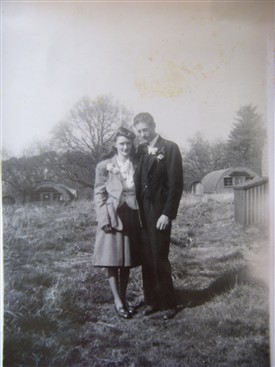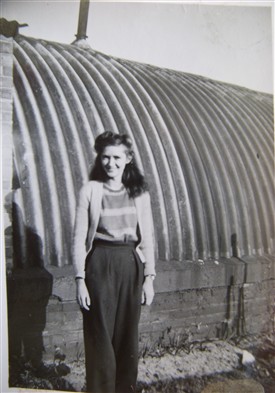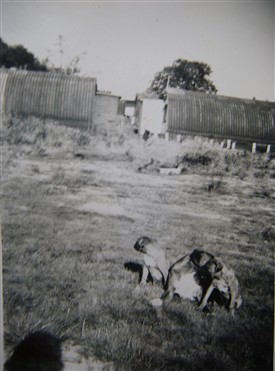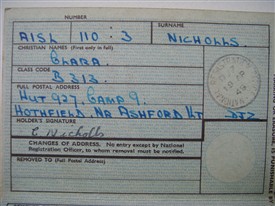From huts to the first Council house

John and Clare on their wedding day
Courtesy John Nicholls

Clare Nicholls at their hut
John Nicholls

John's dogs in front of the huts
John Nicholls

Clare's identity card showing her hut address
Courtesy of Clare Nicholls
The story of John and Clare Nicholls, and their family
By Chris Rogers
Clare Nicholls was born and grew up in London during the Second World War. Her family were not evacuated from the capital and they endured the war at home in London. Clare’s father had jobs which brought with them tied cottages and so did not own their own home.
Soon after the war ended Clare’s family, including her Grandmother and Grandfather, moved down to Hothfield and were housed, by Ashford Borough Council, in a Nissen hut on Waterfall Lane (near Home Farm). The huts had been erected during the war by the army who had used them as billets, training grounds and as a Prisoner of War Camp. Clare was 15 years old when she came to Kent.
Clare took a job in the paper mill at Little Chart a few miles away. John Nicholls worked there too and lived with his grandparents in Little Chart village. The paper mill made ‘flong’ which was a coated card used by the newsprint industry to make moulds for the printing presses. The mill’s main client was the Daily Express but the flong was sent all over the country and possibly abroad.
John and Clare met at the mill and were married in 1949 at Ashford Registry Office. The council kindly provided them with their own Nissen hut as temporary housing in 1949 where they had a small wedding reception party with family.
Their hut was in Hothfield Common just off Cade’s Road. The huts had initially been inhabited by squatters who moved in after the war. Ashford Borough Council cleaned up the huts and lined them, to make them more habitable. Each hut was divided into three sections with a kitchen-diner at the front, a bedroom beyond and a third room which could be another bedroom or living room. The toilet was an elsan bucket in a hut outside and had to be emptied into a drain which was provided on the site.
The hut had only cold running water and a small cast iron ‘kitchener’ for cooking and heating, which needed to be polished with black lead from time to time. When John and Clare first moved into their hut it was full of wood lice who were living in the lining of the hut’s roof. The encampment included a long hut which had formerly been the army cookhouse but which was used as a clinic. John and Clare recall their time in the huts was hard but not unpleasant.
Their eldest daughter, Carol, was born in 1953 while they were still living in this Nissen hut. Carol was born prematurely and struggled through the first months of her life, but is now alive and well and living in nearby Kingsnorth (south of Ashford).
John and Clare stayed in their hut until 1954 whilst the new housing was built in Hothfield village by Ashford Borough Council. Until then the village had been a small hamlet on two streets, consisting of a few houses, a school, church, pub and shop. The site of the new housing had mainly been part of Hothfield Common and was a forest. During the war this part of the Common had been used to hide tanks which were parked amongst the trees. Coach Drive had been heavily made up with concrete by the army and is reputed to be around 18inches thick to carry the weight of the tanks.
Clare and John were the first ever residents to move into the Council houses, and they were not sad to give up their hut. They moved in 1954 whilst the Council was still building much of the rest of the estate. To the back of their house they recall a large iron wrecking ball on a crane which was being used to smash up the army’s tank installations before the next houses could be built.
John and Clare are still in the same house today, and have never moved away. Their son, Stephen, worked in a variety of places during his lifetime but has returned to Hothfield and lives around the corner. Diane, their youngest child, had a love of animals and was always rescuing sick or injured wildlife. Diane spent so much time taking animals to the vets that she eventually worked there for a short time. Local people knew of Diane’s caring nature and would bring injured animals to her to look after – people still brought animals to the house even after Diane had moved away.
All three children grew up in Hothfield and went to the village school (now sadly closed). At one time Clare was a cleaner at the school and John rang the school bell at the start of day and at break times. Clare was also the school crossing patrol (‘Lollipop Lady’) for a while.
John was, at one time, on the Parish Council and is still on the Village Hall committee. John was also responsible for setting up the Hothfield Carnivals during the 1970s and his daughter Diane led the Majorette troop which John also set up. The Majorettes and Carnival Queens also went to other local carnivals with the floats that John created.
John and Clare remember the former village shops and pub, and the hurricane in 1987 which brought down many of the big trees that had been left in the village. John is still active in the village bowls club and plays darts despite being nearly blind.
Clare’s cousin, Joy, lived next door in School Road, and some other former hut dwellers are also still in the village. After these families were rehoused into the new village, the huts became temporarily inhabited by other homeless and travelling families including gypsies. Many of these also then had to be relocated to Council housing before the huts could finally be removed in the late 1950s and the Common could start to be returned to its natural form.
Hothfield Heathlands is now a Site of Special Scientific Interest (SSSI) with many rare plants and insects. The nature reserve still bears evidence of a practice grenade trench and a long gully used by tanks to practice driving onto landing craft in the sandy and boggy conditions.